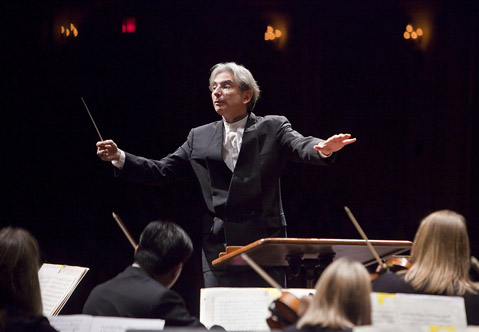San Francisco Symphony at the Granada
Michael Tilson Thomas Brought the Orchestra and One of His Own Compositions

In the fourth CAMA-sponsored appearance of the San Francisco Symphony under the much-admired watch of Michael Tilson Thomas on Saturday at the Granada, the programming plot also included a glance at Thomas as composer. His “Street Song,” written 20 years ago for Empire Brass and expanded for orchestral brass in 1996, served as an accessible little appetizer for the tested (but hardly a warhorse) fare of Haydn’s Symphony No. 60 in C and Brahms’s first symphony in C minor-two ventures into various expressive corners in the key of C.
It should be noted that this was the orchestra’s first concert in the comparative acoustic glory of the Granada Theatre, and the match of this fine-sounding ensemble with this equally fine-sounding hall added to the ambient charm of the night. Throughout the concert, the stage population kept growing, from pared-down brass forces for Thomas’s piece, to the leaner ranks of the classical orchestra format for the Haydn, and finally the full three-dimensional romantic orchestral sound at work in the Brahms.
“Street Song” is a fanfare with echoes of Copland and Bernstein mixed in with fleeting dissonances, savored long-tone brass timbres and swooping melismas. In the end, the piece almost makes more of an impression as a sonic event than as a composition.
Brahms’s First Symphony was written at the ripe age of 42, a delay resulting from his self-critical nature and abject fear of Beethoven’s lofty example. Clearly, this first symphony is influenced by Beethoven in its cast and sweep, but with hints of Brahms’s distinct personality to come. Overall, at the Granada, it was magnificently articulated by the S.F. Orchestra, which was respectful of both its grandeur and the gods in its details.
While the Brahms symphony was positioned as the keynote event on this soloist-free program, the real highlight of the evening came from elsewhere: in the standard classical music scene, we hear too much Brahms and far too little Haydn, the forefather, after all, of the symphony, the string quartet, and the classical composer’s work ethic. Thomas and his orchestra delivered just the right Haydn touch, firm and unwavering in its resolve and collective cohesion, but also light on its feet.
In the deliciously bizarre transition between the adagio and a brief, brisk finale, the strings issue a scruffy gear-grinding passage. It sounds positively postmodern, though penned in 1775. Anytime is the right time to rediscover the splendors-and crackpot wit-of Joseph Haydn.



